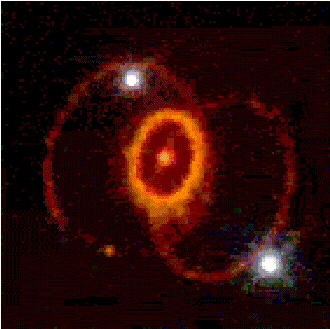
TRANSLATE THIS PAGE INTO ANY LANGUAGE
EXPLODING STARS SUPPLIED
EARTH'S ATMOSPHERE

TELESCOPE REVEALS
FOUNTAIN OF LIFE
Knight Tribune News Service
My Comments In This Color
ATLANTA- A new space telescope has revealed the
inner workings of a stellar factory that produces enormous
quantities of oxygen-what one astronomer called
"the real fountain of life"
This ties in to me, the need to consider the Biblical connections
to Supernova 1987a and Eta Carina
Scientists think most of the oxygen we breathe was
generated initially by a relatively small number of massive
exploding stars known as "supernovae".
Along with other elements-the raw materials of new stars
and planets-this precious gas eventually spread throughout
the universe, including our own solar system.
Without the supernova we would not exist.
Thus how we came into existence would seem
to involve bodies such as SN1987a and Eta Carina
"Such massive stars create lots of oxygen in their
nuclear furnaces", Massachusetts Institute of Technology
astronomer Claude Canizares said yesterday at the annual
meeting of the American Astronomical Society.
"It was explosions of such supernovae that permitted life on Earth".
That last sentence is one to really hang on to.
Without supernova we could not exist
Once life evolved on this planet, oxygen generation by bacteria
and plants became self sustaining.
Thus, humans today are not dependent upon supernovae for oxygen,
although such explosions continue to spread it through the cosmos.
The ring-shaped remnants of one such supernova-labeled E0102-72-
were studied on two occasions last fall by NASA's powerful
new Chandra E-Ray observatory.
When it blew up, the giant star, 15 to 25 times more massive
than our sun , was 200,000 light-years from Earth in the
Small Magellanic Cloud, one of the galaxies closest to our own Milky Way.
(A light-year is about 6 trillion miles).
The brilliant light from the starburst reached Earth about 1,000 years ago
and could have been visible to the naked eyes of people in Australia
or South America Canizares said.
Chandra, launched in July, carries an instrument called a high-energy
spectrometer that spreads out X-rays , much as a prism breaks up a
beam of light, into a rainbow of different wavelengths.
It recognizes each element, such as carbon, oxygen or iron, by
its unique wavelength.
The Chandra images showed that about half the gas expelled by
the exploding star was oxygen-an unexpectedly high amount.
Elements such as iron and magnesium also were manufactured,
but in lesser amounts.
The oxygen from this supernova alone would weigh as much
as 10 of our suns, and would be enough to supply 1,000 solar systems
like our own, Canizares said.
The gas formed inside the star, where nuclear fusion of primordial
hydrogen gradually built up heavier elements, such as carbon,
nitrogen, oxygen, sulfur and iron.
"Understanding supernovae helps us to learn about the processes
that formed chemical elements like those which are found on Earth
and are necessary for life", said Kathy Flanagan another MIT astronomer.
" We have just seen a star rip its belly open and show us what's inside",
Canizares said.
After the oxygen was "baked in the oven", he added,it was "made available to those of us who like to take a breath".
The manufacture of oxygen and other elements in stars continues to this day.
An enormous supernova exploded in 1987 and more are expected
every 2 to 100 years. The last in our own galaxy was in 1602.
However , a huge southern star called Eta Carinae, 9,000 light years away
in the Milky Way may have already blown up during the time it
takes its light to reach earth, according to Stephen Maran,
an astronomer at NASA's Goddard Space Flight Center in Greenbelt Md.
If You Can Help, CLICK HERE
TO RETURN TO THE HIDDEN MEANINGS HOME PAGE CLICK HERE
Non Profit Org. Under New Age Christian Village Church AKA Hidden Meanings
Index
|
American Astronomical Society |
|
|
Massachussetts Institute of Technology Claude Canizares |
Claude Canizares |
|
Massachussetts Institute of Technology Kathy Flanagan |
Kathy Flanagan |
|
NASA Chandra E Ray Observatory |
|